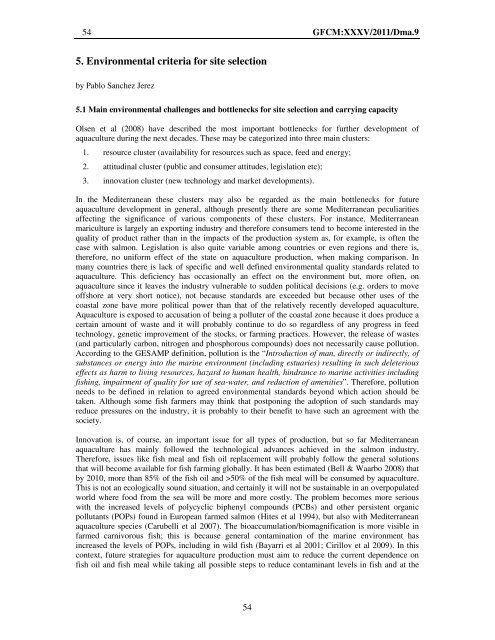Site selection and carrying capacity in Mediterranean ... - FAO Sipam
Site selection and carrying capacity in Mediterranean ... - FAO Sipam
Site selection and carrying capacity in Mediterranean ... - FAO Sipam
Create successful ePaper yourself
Turn your PDF publications into a flip-book with our unique Google optimized e-Paper software.
54 GFCM:XXXV/2011/Dma.9<br />
5. Environmental criteria for site <strong>selection</strong><br />
by Pablo Sanchez Jerez<br />
5.1 Ma<strong>in</strong> environmental challenges <strong>and</strong> bottlenecks for site <strong>selection</strong> <strong>and</strong> <strong>carry<strong>in</strong>g</strong> <strong>capacity</strong><br />
Olsen et al (2008) have described the most important bottlenecks for further development of<br />
aquaculture dur<strong>in</strong>g the next decades. These may be categorized <strong>in</strong>to three ma<strong>in</strong> clusters:<br />
1. resource cluster (availability for resources such as space, feed <strong>and</strong> energy;<br />
2. attitud<strong>in</strong>al cluster (public <strong>and</strong> consumer attitudes, legislation etc);<br />
3. <strong>in</strong>novation cluster (new technology <strong>and</strong> market developments).<br />
In the <strong>Mediterranean</strong> these clusters may also be regarded as the ma<strong>in</strong> bottlenecks for future<br />
aquaculture development <strong>in</strong> general, although presently there are some <strong>Mediterranean</strong> peculiarities<br />
affect<strong>in</strong>g the significance of various components of these clusters. For <strong>in</strong>stance, <strong>Mediterranean</strong><br />
mariculture is largely an export<strong>in</strong>g <strong>in</strong>dustry <strong>and</strong> therefore consumers tend to become <strong>in</strong>terested <strong>in</strong> the<br />
quality of product rather than <strong>in</strong> the impacts of the production system as, for example, is often the<br />
case with salmon. Legislation is also quite variable among countries or even regions <strong>and</strong> there is,<br />
therefore, no uniform effect of the state on aquaculture production, when mak<strong>in</strong>g comparison. In<br />
many countries there is lack of specific <strong>and</strong> well def<strong>in</strong>ed environmental quality st<strong>and</strong>ards related to<br />
aquaculture. This deficiency has occasionally an effect on the environment but, more often, on<br />
aquaculture s<strong>in</strong>ce it leaves the <strong>in</strong>dustry vulnerable to sudden political decisions (e.g. orders to move<br />
offshore at very short notice), not because st<strong>and</strong>ards are exceeded but because other uses of the<br />
coastal zone have more political power than that of the relatively recently developed aquaculture.<br />
Aquaculture is exposed to accusation of be<strong>in</strong>g a polluter of the coastal zone because it does produce a<br />
certa<strong>in</strong> amount of waste <strong>and</strong> it will probably cont<strong>in</strong>ue to do so regardless of any progress <strong>in</strong> feed<br />
technology, genetic improvement of the stocks, or farm<strong>in</strong>g practices. However, the release of wastes<br />
(<strong>and</strong> particularly carbon, nitrogen <strong>and</strong> phosphorous compounds) does not necessarily cause pollution.<br />
Accord<strong>in</strong>g to the GESAMP def<strong>in</strong>ition, pollution is the “Introduction of man, directly or <strong>in</strong>directly, of<br />
substances or energy <strong>in</strong>to the mar<strong>in</strong>e environment (<strong>in</strong>clud<strong>in</strong>g estuaries) result<strong>in</strong>g <strong>in</strong> such deleterious<br />
effects as harm to liv<strong>in</strong>g resources, hazard to human health, h<strong>in</strong>drance to mar<strong>in</strong>e activities <strong>in</strong>clud<strong>in</strong>g<br />
fish<strong>in</strong>g, impairment of quality for use of sea-water, <strong>and</strong> reduction of amenities”. Therefore, pollution<br />
needs to be def<strong>in</strong>ed <strong>in</strong> relation to agreed environmental st<strong>and</strong>ards beyond which action should be<br />
taken. Although some fish farmers may th<strong>in</strong>k that postpon<strong>in</strong>g the adoption of such st<strong>and</strong>ards may<br />
reduce pressures on the <strong>in</strong>dustry, it is probably to their benefit to have such an agreement with the<br />
society.<br />
Innovation is, of course, an important issue for all types of production, but so far <strong>Mediterranean</strong><br />
aquaculture has ma<strong>in</strong>ly followed the technological advances achieved <strong>in</strong> the salmon <strong>in</strong>dustry.<br />
Therefore, issues like fish meal <strong>and</strong> fish oil replacement will probably follow the general solutions<br />
that will become available for fish farm<strong>in</strong>g globally. It has been estimated (Bell & Waarbo 2008) that<br />
by 2010, more than 85% of the fish oil <strong>and</strong> >50% of the fish meal will be consumed by aquaculture.<br />
This is not an ecologically sound situation, <strong>and</strong> certa<strong>in</strong>ly it will not be susta<strong>in</strong>able <strong>in</strong> an overpopulated<br />
world where food from the sea will be more <strong>and</strong> more costly. The problem becomes more serious<br />
with the <strong>in</strong>creased levels of polycyclic biphenyl compounds (PCBs) <strong>and</strong> other persistent organic<br />
pollutants (POPs) found <strong>in</strong> European farmed salmon (Hites et al 1994), but also with <strong>Mediterranean</strong><br />
aquaculture species (Carubelli et al 2007). The bioaccumulation/biomagnification is more visible <strong>in</strong><br />
farmed carnivorous fish; this is because general contam<strong>in</strong>ation of the mar<strong>in</strong>e environment has<br />
<strong>in</strong>creased the levels of POPs, <strong>in</strong>clud<strong>in</strong>g <strong>in</strong> wild fish (Bayarri et al 2001; Cirillov et al 2009). In this<br />
context, future strategies for aquaculture production must aim to reduce the current dependence on<br />
fish oil <strong>and</strong> fish meal while tak<strong>in</strong>g all possible steps to reduce contam<strong>in</strong>ant levels <strong>in</strong> fish <strong>and</strong> at the<br />
54
















